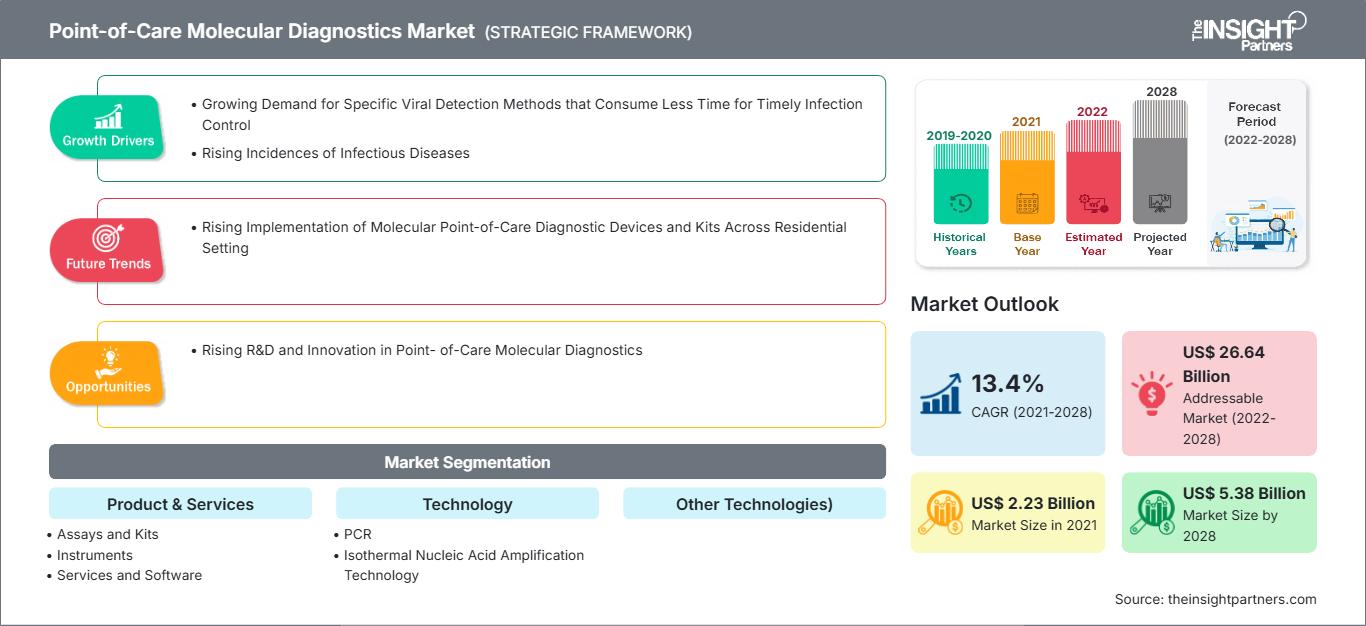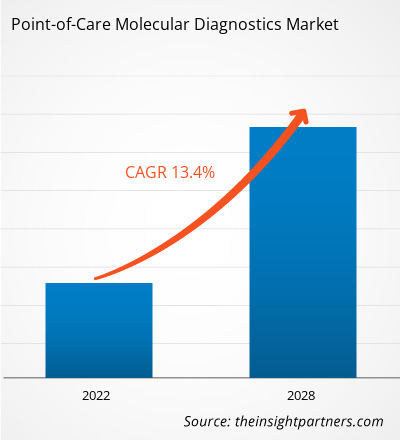[調査レポート]ポイントオブケア分子診断市場は、2021年の22億3,094万米ドルから2028年には53億8,118万米ドルに達すると予測されており、2021年から2028年にかけて13.4%のCAGRで成長すると見込まれています。
市場洞察とアナリストの見解:
ポイントオブケア分子診断には、咽頭スワブ、血液、血清、便などのヒトサンプル中の疾患の検出と診断に使用されるポータブルデバイス、アッセイ、キットが含まれます。分子診断は、そのシンプルさ、利便性、迅速な処理時間、および患者の転帰を改善する可能性により、集中型の研究室から分散型のポイントオブケア分子検査へと移行しています。これらの利点により、リソースが限られている地域や遠隔地での診断に適用できます。感染症の発生率の増加は、効果的な診断の需要を大幅に押し上げています。感染症の制御と排除、原因物質のタイムリーな検出、効果的な治療と疾患制御を可能にする診断ツールの需要の増加は、予測期間中に市場を活性化させるでしょう。さらに、最新技術は、分子診断の分野で目覚ましい変革を可能にしています。世界のポイントオブケア分子診断市場規模は、2021年の22億3,094万米ドルから2028年には53億8,118万米ドルに達すると予想されています。市場は2021年から2028年にかけて13.4%のCAGRで成長すると予測されています。
成長の原動力と課題:
感染症の発生率の増加
感染症の蔓延により、検査のレベルと速度が増加しています。感染症の分子診断検査を検査室からポイントオブケア(POC)へ移行することで、検査の実施頻度と量に革命的な変化をもたらす可能性があります。分子診断は、より高感度な製品およびサービスであり、より低濃度の感染性病原体を検出できるため、従来よりも早期に疾患を検出できます。POC(ポイントオブケア)分子診断は、実用的な結果を得るまでの時間を最小限に抑え、早期感染検出、適切な感染制御措置、そして治療法の臨床試験への登録を促進する可能性を秘めています。インフルエンザA/B型、RSウイルス(RSV)、院内感染(HAI)の蔓延により、POC(ポイントオブケア)分子診断の需要が高まっています。インフルエンザおよびRSウイルス(RSV)のPOC検査は、患者の治療と感染制御を改善することができます。最近では、POC分子診断がCOVID-19感染の検出において重要な役割を果たしました。COVID-19感染の検出において、RT-PCRに基づく診断検査は時間と費用がかかり、高度な機器と専門の人員を必要とします。診断コストの高騰と検査キットの不足により、市中感染のモニタリングが困難になっています。その結果、COVID-19ウイルス感染を迅速かつ手頃な価格で効果的に検出できる方法が緊急に必要とされていました。簡便かつ効果的なPOC(ポイントオブケア)分子診断装置は、現場での検査を可能にし、感染予防と感染拡大の抑制に役立ちます。したがって、感染症を検出するための迅速かつ効果的なPOC分子キットの需要の高まりが、市場の成長を牽引しています。
要件に合わせてレポートをカスタマイズ
レポートの一部、国レベルの分析、Excelデータパックなどを含め、スタートアップ&大学向けに特別オファーや割引もご利用いただけます(無償)
ポイントオブケア分子診断市場: 戦略的洞察

- このレポートの主要な市場動向を入手してください。この無料サンプルには、市場動向から見積もりや予測に至るまでのデータ分析が含まれます。
レポートの一部、国レベルの分析、Excelデータパックなどを含め、スタートアップ&大学向けに特別オファーや割引もご利用いただけます(無償)
ポイントオブケア分子診断市場: 戦略的洞察

- このレポートの主要な市場動向を入手してください。この無料サンプルには、市場動向から見積もりや予測に至るまでのデータ分析が含まれます。
市場の制約
償還削減による価格圧力
医療診断市場は現在、患者の診断に不可欠な様々な検査方法に対する償還不足に悩まされています。償還不足は市場に悪影響を及ぼし、主要経済国の大規模市場は成長が停滞しています。ポイントオブケア(POC)の分子診断検査も、世界各国で同様の償還不足の問題に直面しています。償還制度は一般的に診断検査に不利です。診断検査の償還不足により、検査価格が低く設定され、最終的には業界の収益性と市場規模の縮小につながります。さらに、非効率的な償還構造は、より優れた診断検査の開発を阻害しています。さらに、償還削減は、診断技術の導入意欲の低下と、将来的に改善された検査の不足という両方の問題に直面するため、臨床現場に悪影響を及ぼす可能性があります。さらに、各国は特定の治療に関して独自の償還制度とポリシーを有しています。例えば、米国とドイツの当局は、病気の治療にかかる総費用を病院に補償します。そのため、患者の入院期間が予想よりも長引いた場合、病院が費用を負担することになります。病院や医療センターが追加検査によって利益の減少や患者一人当たりの経済的損失が生じると判断した場合、このシナリオは診断ツールの使用を妨げる可能性があります。そのため、ポイントオブケア分子診断装置のOEMメーカーは、硬直した償還制度のために、多くの官僚的および価格設定上の課題に直面しています。このように、償還問題はポイントオブケア分子診断装置メーカーに価格圧力をかけており、これがポイントオブケア分子診断市場全体の成長に対する大きな制約となっています。
レポートのセグメンテーションと範囲:
「世界のポイントオブケア分子診断」は、製品とサービスに基づいてセグメント化されています。サービス、技術、用途、エンドユーザー、そして地域に基づいて、世界のポイントオブケア分子診断市場は、製品とサービスに基づいて、アッセイとキット、機器、そしてサービスとソフトウェアに分類されます。技術に基づくポイントオブケア分子診断市場は、PCR、等温核酸増幅技術(INAAT)、その他の技術に分類されます。用途に基づくポイントオブケア分子診断市場は、感染症、腫瘍学、血液学、出生前検査、内分泌学、その他の用途に分類されます。エンドユーザーに基づいて、ポイントオブケア分子診断市場は、病院と診療所、診断ラボ、研究および学術機関、およびその他のカテゴリに分類されています。
医療市場におけるポイントオブケア分子診断は、地理に基づいて、北米(米国、カナダ、メキシコ)、ヨーロッパ(ドイツ、フランス、イタリア、英国、ロシア、その他のヨーロッパ)、アジア太平洋(オーストラリア、中国、日本、インド、韓国、その他のアジア太平洋)、中東およびアフリカ(南アフリカ、サウジアラビア、UAE、その他の中東およびアフリカ)、南米および中米(ブラジル、アルゼンチン、その他の南米および中米)に分類されています。
セグメント分析:
技術に基づいて、分子診断ポイントオブケア市場は、PCR、等温核酸増幅技術(INAAT)、およびその他の技術に分類されています。 2021年にはPCRセグメントが市場シェアの大半を占めると見込まれますが、INAATセグメントは予測期間中に最も高い成長率を示すと予想されています。核酸の等温増幅は、一定温度で核酸配列を迅速かつ効率的に蓄積します。この増幅技術はPCRの代替として開発され、DNA、RNA、低分子、タンパク質、細胞、イオンなどのバイオセンシングターゲットに使用されています。等温増幅法によって生成されるアンプリコンは、バイオメディシン、バイオイメージング、バイオセンシングなど、様々な用途を持つ汎用性の高い核酸ナノマテリアルの構築に利用されています。臨床検体の複雑な生化学的性質、臨床検体中に存在する核酸ターゲットの少なさ、そして既存のバイオセンサー技術を考えると、ポイントオブケア検査で使用される少量の検体から臨床的に関連する感度を得るには、何らかの形の核酸増幅が必要となることが示唆されています。
製品とサービスに基づいて、ポイントオブケア分子診断市場は、アッセイとキット、機器、サービスとソフトウェアに分類されます。 2021年には、アッセイおよびキットセグメントが市場で最大のシェアを占めると見込まれ、予測期間中に最速の成長率で成長すると予想されています。ポイントオブケア分子診断アッセイおよびキットは、医師の診療所、病院の集中治療室、外来診療所、地域の診療所向けに特別に設計されています。これらのアッセイおよびキットは、呼吸器感染症や女性の健康および性的な健康状態の早期診断に役立ちます。アッセイキットは主にライフサイエンス研究、環境モニタリング、創薬開発で使用されています。また、疾患経路の研究、潜在的な薬物候補のスクリーニング、バイオ医薬品の製造プロセスの評価など、さまざまな用途にも使用されています。POC ELISA(酵素結合免疫吸着測定)キットは、サンプルからタンパク質や抗原を検出および定量するために広く使用されています。ターゲット特異的 ELISA キットは、免疫検出実験を効率化するために使用されます。
ポイントオブケア分子診断市場は、用途に基づいて、感染症、腫瘍学、血液学、出生前検査、内分泌学、およびその他の用途に分類されています。 2021 年には、感染症セグメントが市場で最大のシェアを占める可能性がありますが、腫瘍学は今後数年間で最も急速に成長すると予想されています。 世界中で約 5,000 万人がてんかんを患っており、これは世界で最も一般的な神経疾患の 1 つです。 北米におけるてんかんの年齢調整発生率は、100,000 人年あたり 16 人から 100,000 人年あたり 51 人の範囲です。 年齢調整有病率は、報告国によって異なりますが、1000 人あたり 2.2 人から 1000 人あたり 41 人の範囲です。社会経済的地位の低い集団では、発作の発生率が上昇します。新規発作の約25%から30%は、他の原因によって誘発されたか、または続発していると考えられています。てんかんの発症率は若年層と高齢層で最も高く、50歳を過ぎると着実に増加します。高齢者の発作とてんかんの最も一般的な原因は、脳血管疾患です。
ジアゼパム、ミダゾラム、ロラゼパムなどのベンゾジアゼピン系薬剤は、発作が持続する場合の第一選択薬として受け入れられています。ベンゾジアゼピン系薬剤に難治性のてんかん重積状態を対象とした、待望のランダム化試験である、確立されたてんかん重積状態治療試験(ESETT)が完了した後も、最適な第二選択薬は不明です。第二選択薬には、ホスフェニトイン、バルプロ酸、レベチラセタムなどがある。
ポイントオブケア分子診断市場分析、地域分析:
地理に基づいて、世界のポイントオブケア分子診断市場は、北米、ヨーロッパ、アジア太平洋、南米および中米、中東およびアフリカの5つの主要地域に分かれています。北米では、米国がポイントオブケア分子診断市場で最大の市場です。米国市場におけるポイントオブケア分子診断デバイスの需要は、ウェアラブル医療機器、ラボオンチップ技術の導入、スマートフォンの利用増加によって推進されています。今後数年間で、HIV、結核、マラリアなどの感染症を特定するための迅速検査の利用可能性が高まり、臨床医と患者がスマートフォンで結果を視覚化し、適切な治療決定を下せるようになることで、業界は変革するでしょう。最新の診断業界の進歩は、治療計画を支援するための迅速な臨床意思決定のための迅速な診断を提供することを目指し、米国のポイントオブケア分子診断市場を牽引しています。
さらに、米国はCOVID-19パンデミックによる最も大きな被害を受けた国の一つでした。タイムリーな治療には、ウイルスの迅速な検査と検出が必要でした。分散型で迅速、高感度、低コストのCOVID-19感染診断を可能にするポイントオブケア(POC)検出技術は、米国を含む世界中で緊急に必要とされています。このように、COVID-19パンデミックは、米国のポイントオブケア分子診断市場に有利な成長機会をもたらしました。さらに、米国における慢性疾患の発生率の急増が、主に市場を牽引しています。例えば、アメリカがん協会によると、2020年に米国で推定180万人の新たながん症例が診断されました。乳がん、肺がんおよび気管支がん、前立腺がん、結腸がんおよび直腸がん、黒色腫、肝臓がんは、よく見られるがんです。
さらに、2020年に疾病管理予防センターが発表した調査によると、約3,420万人のアメリカ人が糖尿病を患っています。同じ調査によると、アメリカの若者の糖尿病発症率は高くなっています。このような疾患の蔓延は、国内のポイントオブケア分子診断の需要を促進するでしょう。さらに、近年、革新的で高度な医療技術が著しく増加しています。この拡大の結果、高度な医療機器が開発され、ヘルスケアビジネスにおける発見とブレークスルーが刺激されました。さらに、米国には最先端のポイントオブケア分子診断に取り組んでいる企業が数多くあります。この要因は、米国のPOC分子診断市場をさらに牽引すると予想されます。
リアルタイムPCR(qPCR)の導入により、医療分野における分子診断の範囲が拡大しました。近年、米国市場における画期的な検査は、POC(Point of Care:患者の近くで実施される分子診断検査)によってもたらされています。分子検査は、従来の患者の近くで実施される迅速診断検査の特異性と感度を向上させることができ、米国のPOC分子診断市場を新たな高みへと押し上げています。この診断検査は、検査室での利用が拡大しており、需要の増加が見込まれます。適切な治療を提供するために特定の状態を早期かつ正確に診断することへの需要の高まりから、新しいテクノロジーが生まれ、米国のPOC分子診断市場が成長するでしょう。
業界の発展と将来の機会:
世界のPOC分子診断市場で活動している主要企業によるさまざまな取り組みを以下に示します。
- 2021年2月、ロシュは、医療従事者がPOCで迅速な判断を下せるよう、SARS-CoV-2迅速抗原検査のFDA緊急使用許可申請を発表しました。
- 2021年3月、bioMéeacute;rieuxは、分子症候群感染症検査を専門とする子会社BioFire Diagnosticsが、BIOFIRE®に対して米国食品医薬品局(FDA)のDe Novo認可を取得したと発表しました。
- 2020年11月、Enzo Biochemは、同社独自のGENFLEX™分子診断プラットフォームで処理された検査が、現在知られているCOVID-19の変異体の存在を検出できることを示した分析結果を発表しました。同社のPCR検査では異なる変異体を区別することはできませんが、陽性サンプルはさらに分析して変異体を識別できます。現在市販されている迅速抗原検査にはこの機能がありません。
- 2021年5月、Biocartis Group NVは、世界的な科学主導型バイオ医薬品企業であるAstraZeneca(LSE/STO/Nasdaq: AZN)と新たな契約を締結したことを発表しました。この契約は、Biocartisの特定の病院サイトで、迅速かつ使いやすいIdylla™EGFR検査製品へのアクセスを提供することを目的としていました。 EGFR 変異を持つ患者の特定をサポートするために、欧州および世界の販売代理店市場を展開しています。
ポイントオブケア分子診断市場の地域別分析
予測期間を通じてポイントオブケア分子診断市場に影響を与える地域的な傾向と要因は、The Insight Partnersのアナリストによって詳細に説明されています。このセクションでは、北米、ヨーロッパ、アジア太平洋、中東・アフリカ、中南米におけるポイントオブケア分子診断市場のセグメントと地域についても説明します。
ポイントオブケア分子診断市場レポートの範囲
| レポート属性 | 詳細 |
|---|---|
| の市場規模 2021 | US$ 2.23 Billion |
| 市場規模別 2028 | US$ 5.38 Billion |
| 世界的なCAGR (2021 - 2028) | 13.4% |
| 過去データ | 2019-2020 |
| 予測期間 | 2022-2028 |
| 対象セグメント |
By 製品とサービス
|
| 対象地域と国 | 北米
|
| 市場リーダーと主要企業の概要 |
|
ポイントオブケア分子診断市場のプレーヤー密度:ビジネスダイナミクスへの影響を理解する
ポイントオブケア分子診断市場は、消費者の嗜好の変化、技術の進歩、製品メリットへの認知度の高まりといった要因によるエンドユーザーの需要増加に牽引され、急速に成長しています。需要の増加に伴い、企業は製品ラインナップの拡充、消費者ニーズへの対応のためのイノベーション、そして新たなトレンドの活用を進めており、これが市場の成長をさらに加速させています。

- 入手 ポイントオブケア分子診断市場 主要プレーヤーの概要
北米の国の中で、米国はCOVID-19の症例数が最も多くなっています。これは、この地域の様々な産業、サプライチェーン、流通チェーンに悪影響を及ぼしています。パンデミックの間、ライフサイエンス企業は、生命を脅かす疾患の治療のための新薬開発に重点を移しました。さらに、迅速検査装置の需要も増加しており、北米のポイントオブケア分子診断市場の成長において重要な役割を果たしています。さらに、COVID-19の継続的な蔓延は、ポイントオブケア分子診断キットの需要を押し上げています。これらのキットの採用は、新製品の開発と発売を後押ししています。2021年3月、ユーロフィンのClinical Enterprise, Inc.は、EmpowerDX COVID-19 Home Collection Kitの消費者直販(DTC)版について、米国食品医薬品局(FDA)から緊急使用許可(EUA)を取得しました。同様に、2020年7月、Eurofins USAのClinical Diagnosticsは、SARS-CoV-2を検出するためのプールPCR検査の提供を発表しました。これにより、顧客のPCR検査1回あたりのコストが大幅に削減されます。
競合状況と主要企業:
世界のPOC分子診断市場で活動している主要企業には、bioMéeacute;rieux SA、F. Hoffmann-La Roche Ltd.、Danaher Corporation、Enzo Biochem, Inc.、Abbott、binx health, Inc.、Meridian BioScience, Inc.、Biocartis、Quidel Corporation、Bio-Rad Laboratories, Inc.などがあります。これらの企業は、世界中で高まる消費者需要に対応し、専門ポートフォリオの製品範囲を拡大するために、新製品の発売と地理的拡大に重点を置いています。彼らは世界中に広く展開しており、それによって多くの顧客にサービスを提供し、結果として市場シェアを拡大しています。
- 過去2年間の分析、基準年、CAGRによる予測(7年間)
- PEST分析とSWOT分析
- 市場規模価値/数量 - 世界、地域、国
- 業界と競争環境
- Excel データセット
最新レポート
お客様の声
購入理由
- 情報に基づいた意思決定
- 市場動向の理解
- 競合分析
- 顧客インサイト
- 市場予測
- リスク軽減
- 戦略計画
- 投資の正当性
- 新興市場の特定
- マーケティング戦略の強化
- 業務効率の向上
- 規制動向への対応




















 無料サンプルを入手 - ポイントオブケア分子診断市場
無料サンプルを入手 - ポイントオブケア分子診断市場